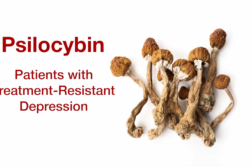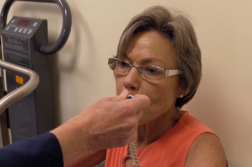BOCA RATON, Fla. (Ivanhoe Newswire) — Every 66 seconds someone in the United States is diagnosed with the most common type of dementia: Alzheimer’s disease. It also kills more people than breast and prostate cancers combined. But a Florida scientist says up to a third of dementia cases may actually be prevented!
Dennis and Jo Battistella know each other about as well as two people can.
“We’ve been married for 37 years. We met down here in a bowling alley,” Jo shared with Ivanhoe.
They also know what they don’t know … or can’t remember.
“We’re both at the age where we know we both forgot things and have issues with memory,” Dennis added.
And Alzheimer’s disease runs in both of their families. So when a clinical trial to cut a person’s dementia risk was announced, they both jumped at the chance.
James Galvin, MD, MPH, Director, Comprehensive Center for Brain Health, Charles E. Schmidt College of Medicine at Florida Atlantic University, explained, “If you look at all the things we know that may be associated with the risk of developing dementia, the two strongest are age and family history, and I can’t change your age and I can’t change your genes.”
But, Dr. Galvin believes he might be able to change how quickly your brain ages. That’s what the dementia prevention initiative is designed to do. Volunteers are given personalized prevention plans tailored to their respective risks. Each plan may include physical therapy, dietary changes, and even psychotherapy. The trial just began a few months ago, but …
“We see reduction in sugar profiles. We see reductions in inflammatory markers,” continued Dr. Galvin.
Studies have linked high blood sugar and inflammation to dementia. So the reduction in both is good news for the 60-something Battistellas.
Dennis said, “You feel more confident now. Don’t worry about things as much as far as memory lapses.”
And they can expect …
“To live a long, happy life together,” Jo said cheerfully.
“And my plan all along was to at least be 90, so maybe 100 now,” stated Dennis.
Even though patients are reporting positive results early in the trial, more research needs to be conducted to see the long-term effects. Nationally, if Alzheimer’s disease and related disorders were delayed by just five years, there would be over five million fewer cases 25 years later, saving 367 billion dollars.
Contributors to this news report include: Milvionne Chery, Producer; Roque Correa, Editor and Videographer.
Free weekly e-mail on Medical Breakthroughs from Ivanhoe. To sign up: http://www.ivanhoe.com/ftk
PREVENTING DEMENTIA?
REPORT #2525
BACKGROUND: More than 5.7 million Americans of all ages are living with Alzheimer’s dementia in 2018. This number includes 5.5 million people age 65 and older and approximately 200,000 individuals under age 65 who have younger-onset Alzheimer’s. Almost two-thirds of Americans with Alzheimer’s are women. Someone in the United States develops Alzheimer’s every 65 seconds. By mid-century, someone in the United States will develop the disease every 33 seconds. Alzheimer’s disease is the sixth-leading cause of death in the United States, and the fifth-leading cause of death among those age 65 and older. It also is a leading cause of disability and poor health. Between 2000 and 2015, deaths from Alzheimer’s disease as recorded on death certificates increased 123 percent, while deaths from the number one cause of death (heart disease) decreased 11 percent. Among people age 70, 61 percent of those with Alzheimer’s are expected to die before the age of 80 compared with 30 percent of people without Alzheimer’s — a rate twice as high.
(Source: https://www.alz.org/facts/)
DIAGNOSIS AND TREATMENT: There’s no specific test today that confirms you have Alzheimer’s disease. Your doctor will make a judgment about whether Alzheimer’s is the most likely cause of your symptoms based on the information you provide and results of various tests that can help clarify the diagnosis. Current medications can help for a time with memory symptoms and other cognitive changes. The most common medications used to treat cognitive symptoms are cholinesterase inhibitors. These drugs work by boosting levels of a cell-to-cell communication by providing a neurotransmitter that is depleted in the brain by Alzheimer’s disease. Another common medication is memantine. This drug works in another brain cell communication network and slows the progression of symptoms with moderate to severe Alzheimer’s disease. Study results have been mixed about whether diet, exercise or other healthy lifestyle choices can prevent or reverse cognitive decline. However, these healthy choices promote good overall health and may play a role in maintaining cognitive health, so doctors encourage regular exercise, especially cardiovascular exercise, a diet low in fat and rich in fruits and vegetables, and social engagement and intellectual stimulation.
(Source: https://www.mayoclinic.org/diseases-conditions/alzheimers-disease/diagnosis-treatment/drc-20350453)
NEW RESEARCH: A team of researchers led by Dr. Mathias Jucker, at the German Center for Neurodegenerative Diseases in Tubingen, Germany used a new type of tissue sample staining dye, called luminescent conjugated oligothiophenes (LCOs), to illuminate previously unseen structural forms of amyloid fibrils. Amyloid fibrils are aggregates of the peptide beta-amyloid that form plaques associated with neurological decline found in the brains of people with Alzheimer’s. Jucker and his team analyzed donated postmortem brain tissue samples from people who had Alzheimer’s caused by family-carried genetic mutations, as well as other samples from typical and rare types of Alzheimer’s. They found that amyloid expressed unique spectral signatures in some, but not all, of these different types of the disease, such as slow-progressing versus fast-progressing. These amyloid spectral signatures varied within individual patients, but distinct areas of the brain showed similar average signatures. Next steps for the research team include using the new method to further explore mechanisms behind the different amyloid shapes in different types of Alzheimer’s, how they relate to severity of dementia symptoms, and how they might inform future potential targets for treatment.
(Source: https://www.nia.nih.gov/health/alzheimers/dementia-research-and-clinical-trials)
* For More Information, Contact:
James Galvin, MD, MPH Gisele Galoustian, Media Relations
healthybrain@health.fau.edu GGALOUST@fau.edu
(561) 297-2676



